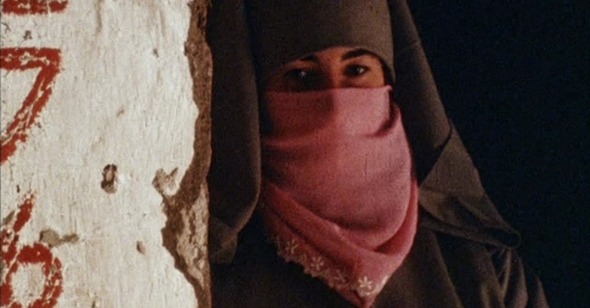Oppositional Art
Ela Bittencourt on Mónica Savirón’s series On Resistance
On Resistance shows Friday, January 13, with curator Mónica Savirón in person, as part of Museum of the Moving Image’s First Look 2017.
Art critic Jerry Saltz wrote in a recent article in Vulture that what New York City needs most from its art institutions is a firmer commitment to exhibiting the latest art. Historical surveys, particularly from the latter half of the 20th century, are all too common, Saltz says, leaving little room for showcasing fresh talent. In this context, Mónica Savirón’s new program of international avant-garde film and video, which she curated for the Museum of the Moving Image, On Resistance, is a happy combination. It celebrates older works—most of them forgotten—while placing a strong emphasis on the new. Alongside renowned artists such as Philippe Cote, who died in November 2016, are younger filmmakers, like Charles-André Coderre of Canada’s Double Negative Collective. The term “resistance” emerges as an urgent call, for both a commitment to contemporary issues and to form. Savirón notes, “On Resistance brings together different generations of makers whose work, produced in fifteen different countries, confronts the lures of power and narcissism through disarming generosity, responsible criticism, and self-awareness. Projecting on film all the works that were conceived to be finished on celluloid is also part of this resistance.”
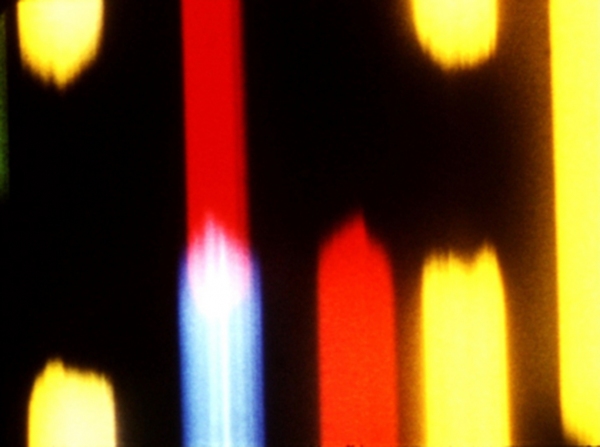
The permutations of resistance vary. Philippe Cote’s 2002 L’en-Dedans (Inside the Inside), a super-8 film projected on 16mm, explores the mechanical processes that constitute filmmaking. Color lights flash and disappear into pitch-black background in this minimalist, cameraless, 18-minute silent film. Sitting through it is a form of meditation, an effort to capture where the light ends and darkness begins, a struggle to discern contours and forms (lines, circles), and to regroup, before another color appears. In the constant procession of bursts, no hue stands alone, but rather, much like in an Impressionist painting, appears as a compound of colors bleeding into each other. In another segment, parallel bars of color are stirred and disturbed as a burst of light runs across them. Deliberately disorienting, the film reflects what Savirón in her program notes calls Cote’s expression of his inner self: a luminosity that “signals connection, maybe hope.” We are reminded that color is deeply subjective, and that to immerse oneself in it means to surrender to sensory experience, to withhold judgment. The uncertainty, or ambiguity, that lingers over this film gives a new meaning to the idea of resistance, in this case suggesting that the tangible, more easily identifiable world is being withheld.
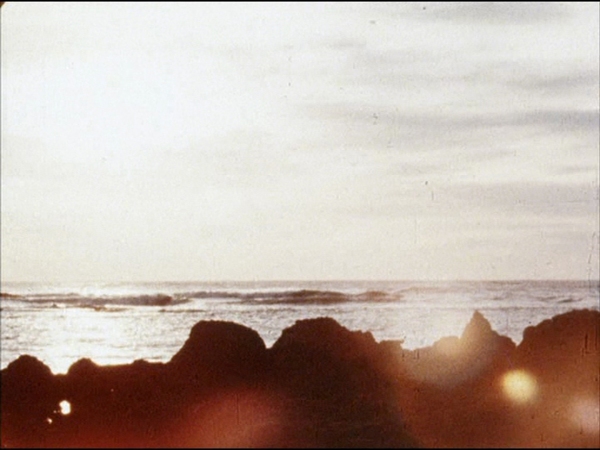
The most enigmatic work in the program, Don Levy’s 16mm color short Malaise (1963-64) opens with an image vaguely reminiscent of Ingmar Bergman’s The Seventh Seal: a dark male silhouette traverses a rocky, barren terrain, at times against what looks like the ruins of a Moor castle. The film is part of a compilation, Five Film Poems, a title that suggests that Levy, who was a chemical physicist and researcher by training, is interested in film as a plastic art, capable of allegorical synthesis, much like poetry. As a film poem, Malaise eludes interpretation. What malignity is being depicted? Is the solitary figure a prophet or a pilgrim, and how does the voiceover—with lines recited by British filmmaker Peter Whitehead that speak of a mysterious plague, and reverberate in echoes that obscure their meaning—connect to the pilgrim? It does not help that the text is adapted from Portrait of a Man Unknown, by Nathalie Sarraute, a French nouveau roman author, whose objectives were stream of consciousness and the obliteration of any notion of knowable, easily quantifiable self, giving room to myriad sensory experiences. We are therefore on shifty ground, at the confluence of ethnography, sensory experimentation, and possibly, fantasy. Throughout the film, images of valleys, of Moroccan structures, faces and architectural details mingle with the pictures of bare bones and skulls, forming a mosaic that fractures faster than we can assimilate it. A result is a hallucinatory journey, a baroque prophecy that titillates, as if it contained a Rosetta stone capable of solving enigmas, yet ultimately remains opaque.
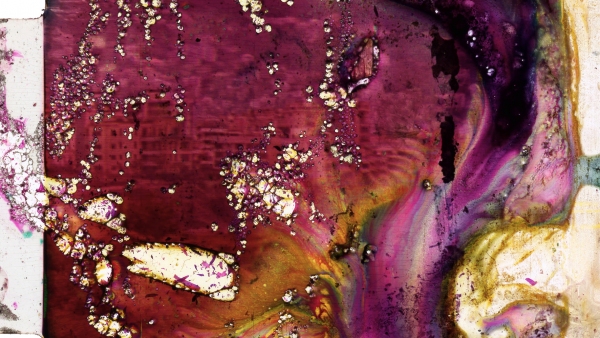
Lebanese-Canadian filmmaker Charles-André Coderre’s Granular Film – Beirut (2016), shown in 35mm and shot on a 16mm Bolex camera, shares a similar preoccupation with rendering the difficulty of perceiving, and of recollection. Coderre dramatizes the process of memory: the image is not only grainy and scratched, but it also contains blotches of green, as if the city were being subject to degradation, the touches of civilization, of man, erased by wild nature. At the same time, the green areas invoke the infrared view of a gun’s blinder—with heat appearing green—an image familiar from war films. Increasingly, the imagery becomes dynamic—the music throbs, and the sea, featured in the background, turns into a storm—until it dissolves into pure color, as in a Joni Mitchell painting. Similarly to Cote’s film, the barrier between “inside” and “outside” is continually broken: the concrete place, Beirut, is finally but a mental image, amorphous and subject to disintegration. As the film unfolds, it is harder to get a bearing on the landscape or on physical markers: a cross on a hill, snippets of street signs, of words, windows and light poles construct a map that cannot be decoded, a maddening tapestry of color that threatens to engulf it all. Of the films in the program, Coderre’s comes closest to painting, thanks to the techniques of mordançage (bleaching and degrading) and to chromaflex color processing. Yet its haunting effect also stems from photographic images snuck in, under the cover of abstraction—a dualistic approach to seeing, dramatizing the image’s inherent resistance.
,_by_Annalisa_D._Quagliata,_courtesy_of_the_artist_01_.jpg)
Resistance does not merely denote commitment to personal memory or artistic practice. In other examples in the program, the word takes on a political slant—most clearly in the 16mm short from 2016 by Mexican director Annalisa D. Quagliata, Ñores (sin señalar) (Misters—Without Blame). The archival images in Quagliata’s piece are brutal—they tell of Mexico’s political violence, including over 100,000 students murdered in eight years. Quagliata re-photographs this material and lays over them the soundtrack of a remixed popular song, “Veracruz,” by Agustín Lara. The song begins with nostalgic lines about being born “under the silver moon,” with a “pirate’s soul.” Dots, spots, and blotches flash on the screen, obscuring the portrait of murdered photojournalist Rubén Espinosa. But the soundtrack gets stuck on the line that ends with the word “Veracruz.” As the word repeats, another black-and-white photograph reveals a scene of a violent assassination. The perpetual sound loop creates a grating effect, and enhances the oppressiveness of the images. The interwoven fragments of speeches from protests remind us that the dire situation in Mexico is hardly new. The word “Veracruz” splinters into the last name of yet another victim, activist Nadia Vera, and “cruz” or “cross,” a symbol of martyrdom. By stringing together disparate imagery, Quagliata appears to call out the tabloids that sensationalize the images of massacres, while also giving too much credence to politicians who vow to end them—an endless cycle that, like the stuck song, fails to bring change.
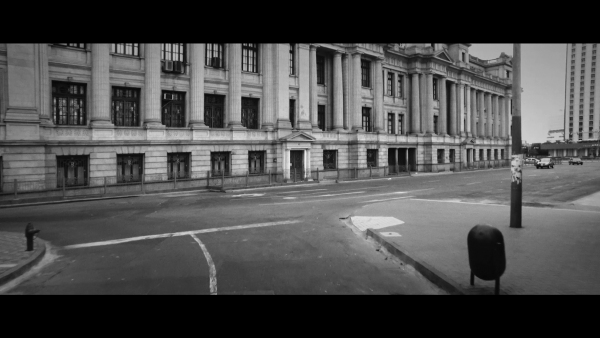
While most of the films presented in On Resistance explore the possibilities offered by traditional analog or early cameraless cinema, Peruvian filmmaker Diego Lama takes a technological step forward, shooting his short digital film entirely from a drone’s flight over a rundown neighborhood in Lima. His four-minute black-and-white 2015 short De falso a legal en una toma (From False to Legal in One Take) takes us through a somber street, with rundown houses and occasional passersby. The camera floats through the area, leading up to a magisterial building. As the camera turns a corner, splendor and squalor are within view, side by side. Further sweep and we realize that the grand building is the Palace of Justice—an imposing colossus that betrays almost no sign of human activity. Lama’s use of technology is as political as his theme: the drone, as a mechanical eye, is cold and objective. Unlike the other works in On Resistance, which emphasize human interference in the filmmaking process, Lama’s film is, to a large extent, auto-generated. Thus Lama’s film can be read as a powerful critique of the law’s pretentions to objective science, while, as social practice, it often benefits the powerful few, disenfranchising scores of others. Against the self-consciously aesthetic approaches, Lama’s comes across as a most straightforward indictment. At its center lies neoclassical architecture, itself an atavistic idea of returning to the ancients’ purity of form, in strike contrast to the makeshift structures in some of the poorer sectors of Latin American cities.
Lama’s single-take approach offsets the majority of films in On Resistance, whose lineage harks back to the Soviet montage. This is particularly the case with Levy, who was fascinated by both Sergei Eisenstein and Lev Kuleshov, as well as by the questions of perception and time, as seen in his experimental collage film Time Is (1964), made for the Nuffield Foundation Unit for the History of Ideas (available to watch online on the BFI Player). It is striking that the work of such a vital and purposeful artist should have been partly forgotten. In this light, Savirón’s curating—combined with her research, the help of the likes of filmmaker John Gianvito, and the preservation efforts of The Don Levy Project members and the Academy Film Archive—makes her own practice a form of resistance. In Savirón’s words, “As a filmmaker myself, I [am aware that] established discourses and dynamics cannot go on unquestioned as normal paradigms. That is the reason why this program shares archival prints that have been obscured by a largely incomplete avant-garde cinema history.” It is apt then that Levy made Malaise, which is making its New York premiere at Moving Image, from the discarded outtakes of his other short films—and it is this detritus that Savirón excavates, elevating the rejected and the mundane. Celebrating it as art.
